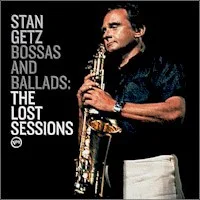Bitrate: 320K/s
Time: 68:30
Size: 156.8 MB
Styles: Saxophone jazz, Bossa Nova
Year: 2003
Art: Front
[7:21] 1. Sunshower
[7:59] 2. Yours And Mine
[7:49] 3. Joanne And Julia
[7:22] 4. Soul Eyes
[7:53] 5. Spiral
[8:13] 6. Beatrice
[8:54] 7. The Wind
[6:34] 8. El Sueno
[6:22] 9. Feijoada
First off, these "Lost Sessions" were never actually lost. The music here was supposed to be released as the Stan Getz Quartet's first issue on A&M, and for the usual record company reasons, it was shelved instead. The tapes were in the vault and catalogs, so it's not like they were found in someone's closet. The bottom line is that Getz, already ill at this point, still had the goods. Produced by Herb Alpert (a genius in his own right even if his records don't always hold up), the bossas here are tough, innovative jazz tunes mainly written by Getz's pianist, Kenny Barron. Don't look for the gentle side of Getz that was so beautifully displayed on his early bossa records with Charlie Byrd and Antonio Carlos Jobim. Instead, this is the man who had reinvented his playing technique. With a strong foil in Barron, Getz was free to explore his form of melodic improvisation to a fuller and wider extent, which is evident if you simply check out his solos on Barron's "Sunshower" and "El Sueno," and Mal Waldron's classic ballad "Soul Eyes." Interestingly, this was Barron's date as much as it was Getz's. His compositions and musical direction are key here, and he was trying to get deeper into and stretch the samba groove in his writing. Finding Getz in such an adventurous space in his playing allowed for this. With a rhythm section that includes bassist George Mraz and drummer Victor Lewis, this disc is essential not only for fans of Getz and Barron, but for real jazzheads. ~Thom Jurek
Bossas and Ballads: The Lost Sessions








